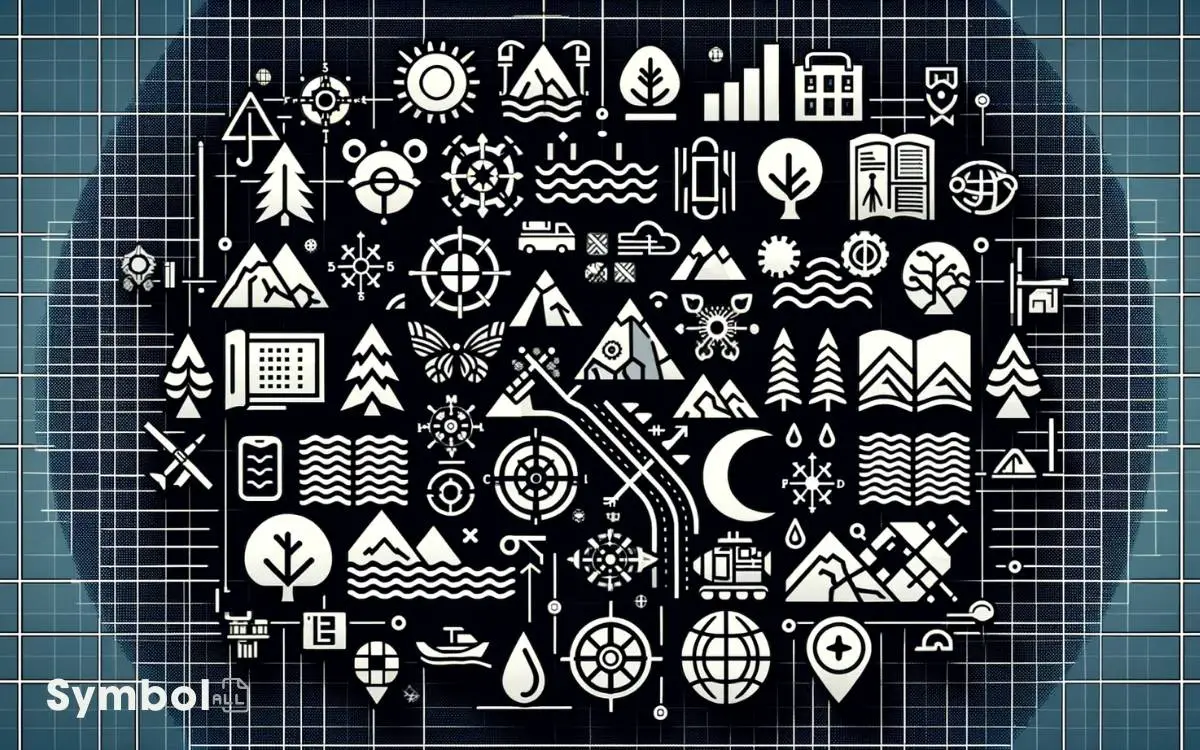Common Symbols Used in Maps: Road Signs!
In map reading, you’ll encounter symbols that reveal the world’s geography and guide your orientation. Road signs with distinct shapes and colors adhere to international norms; for instance, an octagonal stop sign universally means halt.
Blue lines tell the tale of rivers, while triangles mark mountain peaks. For exploring cityscapes, look for symbols indicating restrooms or drinking water, crucial for outdoor adventures.
Parks and recreational areas are depicted with green patches or tree icons, inviting you to explore nearby natural wonders.
Symbols on maps not only enhance your orientation experience but also deepen your understanding of the environment around you, unlocking a world of exploration possibilities.

Key Takeaways
Road and Highway Signs
Why do travelers rely so heavily on road and highway signs?
In essence, these signs serve as essential tools for navigation, ensuring you reach your destination safely and efficiently. They’re meticulously designed to communicate important information quickly and clearly, even at high speeds. They utilize universally recognized colors, shapes, and symbols to convey their messages, making them accessible to a wide audience. The symbols used in daily life, such as arrows, numbers, and icons, play a critical role in reducing confusion and enhancing understanding. Without these visual cues, navigating the complexities of modern roads and transportation systems would be far more challenging.
For example, the distinct shapes and colors of signs aren’t arbitrary; they follow international standards to signal their significance. A stop sign’s octagonal shape and red color universally mean to halt, while a triangular yield sign advises caution.
Additionally, directional signs use arrows and concise language to guide you, reducing the chances of getting lost. Speed limit signs, indicating how fast you’re allowed to go, are vital for safety.
Understanding these symbols isn’t just helpful; it’s necessary for a safe journey.
Topographical Features
When you’re exploring a map, you’ll find that points are vital for pinpointing elevation changes and water bodies. They’re represented by specific symbols that allow you to understand the landscape at a glance.
For instance, a triangle might denote a mountain peak, while blue lines could indicate rivers or streams.
Identifying Elevation Changes
To accurately identify elevation changes on maps, you’ll need to familiarize yourself with the various topographical symbols that represent different landforms and gradients. Understanding these symbols is essential for interpreting the landscape’s shape and relief accurately.
Here’s what to look for:
- Contour Lines: Closely spaced lines indicate steep slopes, while wider gaps suggest gentle slopes.
- Spot Elevations: Specific points marked with their elevation above sea level.
- Hachures: Short lines used to depict cliffs and overhangs.
- Shaded Relief: Shading on one side of terrain features to indicate slope direction.
These elements combined give you a detailed picture of the terrain, allowing you to visualize the elevation changes and landscape features effectively. Knowing how to read them enhances your map-reading skills significantly.
Water Bodies Representation
Having covered how elevation changes are represented on maps, we’ll now explore the symbols used to depict various water bodies, an equally important aspect of topographical features.
Lakes and ponds are often shown as blue shapes, mirroring their natural appearance from above. Rivers and streams are represented by sinuous blue lines, with their flow direction occasionally indicated by arrowheads.
For larger bodies of water like seas and oceans, cartographers use a combination of light and dark blue shades to denote depth, with darker tones indicating deeper areas. Wetlands may be marked with a combination of blue and green, highlighting their mix of water and vegetation.
Understanding these symbols allows you to grasp a map’s hydrography at a glance, enhancing your comprehension of the natural landscape.
Water Bodies and Flow
Understanding the symbols representing water bodies and their flow on maps is crucial for accurately interpreting these important geographical features.
When you’re exploring or planning, recognizing these elements can greatly enhance your understanding of the terrain.
- Blue Lines: Represent rivers and streams, with the flow direction often indicated by arrows.
- Wavy Blue Lines: Denote smaller streams or creeks, suggesting less water volume compared to solid blue lines.
- Blue Shading: Identifies larger water bodies like lakes and oceans, providing a clear visual of water expanses.
- Dashed Blue Lines: Symbolize intermittent streams or rivers that may not always be filled with water, depending on the season or current weather conditions.
These symbols allow you to grasp the hydrographic features of the area, aiding in exploration and environmental comprehension.
Vegetation Types
Moving on to vegetation types, you’ll find that symbols for forest coverage and grassland areas are essential for understanding a map’s depiction of natural landscapes.
When you look at these symbols, you’re seeing the map’s method of distinguishing dense forests from open grasslands.
Each symbol is carefully chosen to represent the specific vegetation type, making it easier for you to interpret the natural features of the area.
Identifying Forest Coverage
In maps, symbols depicting various shades of green typically represent the diversity of forest coverage, ranging from dense woodlands to sparse shrublands.
When you’re trying to identify the type of vegetation in a specific area, it’s important to pay attention to these variations in green.
Here’s what you need to look out for:
- Dark green areas usually indicate dense forests, where the canopy is thick and light barely penetrates to the forest floor.
- Medium green shades often signify mixed woodlands, where there’s a balance between tree coverage and open spaces.
- Light green typically represents sparser vegetation, such as shrublands or areas with scattered trees.
- Patterned green areas can indicate specific types of forests, such as coniferous or deciduous, depending on the map’s legend.
This color coding helps you quickly grasp the nature of the terrain without getting bogged down in textual descriptions.
Grassland Areas Marked
After exploring the shades of green that denote forest coverage, let’s now focus on how maps mark grassland areas, another essential vegetation type.
Grasslands, which vary greatly from savannas to prairies, are depicted using specific symbols and colors that distinguish them from other vegetation types.
| Symbol | Color | Grassland Type |
|---|---|---|
| \ | Light Green | Prairie |
| /// | Yellow-Green | Savanna |
| .. | Beige | Steppe |
| == | Olive | Temperate |
Each symbol provides a quick visual reference to understand the type of grassland represented. Light green slashes (\) typically signify lush prairies, while a series of dots (..) often denote the more arid steppes.
Understanding these symbols enhances your map-reading skills, allowing for a deeper comprehension of the terrain’s vegetative landscape.
Urban Areas
Within the realm of map symbols, urban areas are typically represented by specific icons or shading patterns to accurately depict densely populated regions.
When you’re exploring a map, recognizing these symbols is essential for understanding the layout of cities and towns.
Here are key indicators to look for:
- Dense grid patterns: Representing the street layout, often found in city centers.
- Shaded blocks: Indicating built-up areas, with darker shades often signifying more dense regions.
- Outlined areas: Sometimes, urban boundaries are marked with outlines to differentiate them from surrounding landscapes.
- Specific icons: Certain maps use icons to denote urban centers, such as miniature buildings or skyscrapers.
Public Facilities
When you’re exploring a map, recognizing symbols for public facilities like restrooms and drinking water points is crucial. These icons guarantee you can quickly find basic amenities without hassle.
Paying attention to these markers helps you navigate more efficiently and comfortably in any urban environment.
Identifying Restrooms Icons
You’ll often find restroom icons on maps, easily recognizable by their simple, universally understood symbols representing male and female facilities.
These icons play an important role in guiding individuals to essential amenities, ensuring comfort and convenience during travel or outings.
Here’s what to look for:
- Stick Figures: Traditional male and female stick figures are common, with the female figure often depicted in a dress shape.
- Pictograms: Abstract human figures without specific gender details, promoting inclusivity.
- Text Labels: The words ‘Men’ and ‘Women’ or universal symbols accompanied by text for clarity.
- Accessible Restroom Icons: A standard wheelchair symbol indicates facilities designed for accessibility.
Understanding these symbols enhances your navigation experience, allowing for quick identification of restroom facilities without confusion or delay.
Locating Drinking Water
Just as locating restrooms is important for comfort on the go, finding drinking water facilities ensures you stay hydrated during your adventures.
On maps, symbols for drinking water are usually straightforward but can vary slightly depending on the map’s design. Typically, you’ll look for an icon resembling a water droplet or a faucet.
Sometimes, it’s presented as a cup or bottle with water droplets to indicate a refill station. These symbols are often blue, reflecting the color most commonly associated with water.
It’s vital to familiarize yourself with these icons before heading out, especially if you’re exploring areas where potable water isn’t readily accessible.
Remember, staying hydrated is essential for enjoying any outdoor activity, and knowing how to locate drinking water on a map is a skill that’ll serve you well.
Parks and Recreational Symbols
Parks and recreational symbols on maps guide you to public spaces designed for leisure and outdoor activities. These symbols are essential for planning your visits or activities in an area.
Here’s a quick rundown of common ones:
- Green areas or trees: Indicate the presence of parks or forests.
- Picnic table icon: Points out picnic areas where you can enjoy a meal outdoors.
- Swimming icon: Shows locations of public swimming pools or natural swimming spots.
- Trail marks: Represent hiking or biking trails, guiding you through routes for exploration.
Understanding these symbols enhances your outdoor experience by easily locating facilities and areas dedicated to recreation. Always check a map’s legend for specific symbols used, as they can vary slightly between different mapping services or publications.
Railways and Transit Lines
Traveling through cities and regions, railway and transit line symbols on maps are essential for identifying public transportation options available to you.
These symbols, often represented by solid or dashed lines, indicate the presence of underground, overground, or elevated trains. The color of the line might tell you which line you’re looking at, especially in systems with multiple routes.
Stations are usually marked with a dot or a special icon, sometimes including the station name for easier navigation.
When you’re planning your journey, paying attention to these symbols can help you understand how to move efficiently from point A to B.
It’s also helpful to note any crossings or junctions, as these points might influence your travel time. Understanding these symbols guarantees you won’t miss out on the fastest or most direct routes.
Airports and Airstrips
While railways and transit lines guide you through the intricacies of urban landscapes, airports and airstrips serve as gateways to the skies, marking points where journeys can leap across continents and oceans.
On maps, these essential transportation hubs are symbolized distinctly to guarantee you can easily identify them.
- Airplane symbols often indicate airports, with varying designs to show size or type.
- Runway markings highlight airstrips, especially in less populated areas.
- Helipad symbols are used for helicopter landing areas, often found in remote or specialized locations.
- Circle or semi-circle designs can denote smaller or private airstrips, differentiating from major airports.
These symbols help you pinpoint where air travel facilities are located, aiding in navigation and trip planning.
Natural Hazards
Understanding the symbols for natural hazards on maps is essential, as they alert you to potential dangers such as flood zones, earthquake fault lines, and volcanic activity areas.
Flood zones are typically marked with blue shading or wave patterns, indicating areas prone to flooding.
For earthquake fault lines, look for jagged, vital symbols that trace the fault’s path across the landscape. These lines are important for understanding seismic risk.
Volcanic activity areas, meanwhile, are often represented by a simple triangle, which mimics the shape of a volcano. This symbol helps you identify regions where volcanic eruptions could occur.
Historical and Cultural Sites
Often, maps incorporate symbols to indicate historical and cultural sites, guiding you to areas rich in heritage and tradition. These symbols serve as a gateway to understanding the historical significance and cultural richness of a location.
Here’s what you should look for:
- Museum Icons: Often depicted as a classic building facade, guiding you to repositories of knowledge and history.
- Historical Landmark Symbols: These can range from a simple flag to a specific monument icon, indicating sites of historical importance.
- Cultural Icons: Symbols representing theaters, galleries, or cultural institutions, highlighting areas of artistic and cultural activity.
- World Heritage Sites: A symbol that often resembles a globe or a designated emblem, pointing you towards locations recognized for their universal value to humanity.
These symbols enrich your map-reading experience, allowing you to explore and appreciate the world’s diverse cultural and historical landscapes.
Borders and Boundaries
In mapping, borders and boundaries are essential symbols that delineate the edges of countries, states, and other administrative regions, guiding you through the geopolitical landscape of the world.
These lines aren’t just arbitrary; they’re carefully drawn to reflect treaties, historical agreements, and sometimes contentious decisions.
On a map, you’ll typically see international borders marked with solid or dashed lines, depending on whether they’re undisputed or not.
State and provincial boundaries within a country might be represented with different styles of lines to distinguish them from international borders.
It’s important to pay attention to these symbols as they not only help you understand where one jurisdiction ends and another begins but also inform you about the sovereignty and territorial integrity of the areas you’re exploring.
Land Use and Property Lines
Maps frequently delineate land use and property lines, providing critical insights into how areas are utilized and owned.
Understanding these symbols can help you grasp the layout and function of the land, whether you’re examining a city’s zoning or identifying property boundaries in rural areas.
Key symbols include:
- Dotted lines: Often represent property boundaries, distinguishing one owner’s land from another.
- Shaded areas: Indicate different types of land use, such as residential, commercial, or agricultural zones.
- Color coding: Helps quickly identify specific land uses; for example, green might signify parkland or conservation areas.
- Hash marks: Can denote undeveloped or restricted land, alerting you to areas that might’ve access limitations or special regulations.
Conclusion
As you’ve journeyed through the atlas of symbols, you’ve become versed in the language of maps. From the serpentine trails of roads and highways to the lush whispers of vegetation types, each symbol tells a story.
You’ve navigated through water bodies, brushed past urban sprawls, and tread lightly around natural hazards. Even stepped back in time at historical sites, all while understanding the invisible lines that define our world.
Remember, every map is a time machine, guiding us through both space and history.






